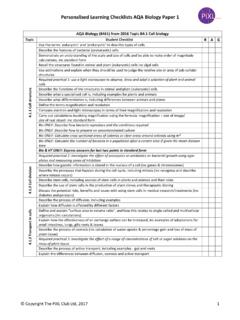Transcription of EXAM WEIGHT 23% CHAPTERS REFERENCED 14-16
1 Program DesignDOMAIN THREEEXAM WEIGHT 23% / CHAPTERS REFERENCED THREEDOMAIN THREE /PROGRAM DESIGNThe type of training program that will deliver the best client results is one that s comprehensive, periodized, and progressive. After you have collected the necessary client data, including a detailed snapshot of their lifestyle, occupation, goals, and interests, along with any medical parameters or issues, you can develop your client s individualized exercise program. Program design does not need to be complicated or confusing. It should be an organized blueprint for solving your client s problems and helping them achieve their goals. You will use your knowledge and expertise to address strength, cardio fitness, flexibility, and overall performance of the body. You will be able to implement acute program variables to influence physiological adaptations.
2 ELEMENTS OF FITNESS There are four elements of fitness programs and they include strength, cardio, flexibility, and body TRAINING Strength is the ability to contract muscles with maximum force given certain constraints. It s also a key factor in fat loss. There are different categories of strength. Limit strength is the amount of force you can generate for on all-out effort without the use of work producing aids. There are three types: Eccentric strength is the strength required to resist and control the resistance in the downward phase of a movement. Static strength is the strength required to resist and control the WEIGHT resistance in a stationary position. Concentric strength is when the muscles generate enough force to exceed the load opposing its contraction. It s usually the upward phase of a movement.
3 Absolute strength is the same as limit strength but adds an element of being under the influence of a work-producing aid like supplements. Speed strength is the ability of the neuromuscular system to produce the greatest impulse (either force or motor unit recruitment) in the shortest amount of time. Anaerobic strength is force produced without oxygen. Linear anaerobic strength endurance is a sustained, all-out maximum effort over an extended period Program THREEDOMAIN THREE /PROGRAM DESIGN of time. It can be achieved by maximum running speed or completing repetitions in bodybuilding. Nonlinear strength endurance is the ability to perform an activity with increasing explosiveness over a period of time. For example, a three- or four-hour powerlifting competition. Aerobic strength is the efficiency which you can use and deliver oxygen to muscles and remove waste over a period of timeCARDIOVASCULAR TRAINING Cardiovascular fitness is the capacity to take in, transport , and utilize oxygen.
4 Specifically, the efficiency at which the heart and lungs can provide oxygen-rich blood to working muscle tissue. Key aerobic training terms used in fitness include: Oxygen deficit - the occurrence when you begin to exercise and your intake of oxygen doesn t immediately meet your demands Oxygen debt - when inspired oxygen during the recovery phase from exercise is in excess of resting needs Aerobic fitness - the capacity to take in, transport , and use oxygen Aerobic exercise - moderate activity places demand on oxygen-using pathways Aerobic strength endurance - musculoskeletal force and energy production that requires oxygen Maximal oxygen consumption - (also referred to as O2 max and maximal oxygen uptake) is the maximum amount of oxygen that can be transported to the body s tissues from Note: To achieve benefits at designated rep.
5 Range, final rep. should be performed at or near reps7 reps10 reps12reps16 reps20 reps30 repsMuscle StrengthVery HighHighMedMedMed/LowLowLowHypertrophyMe d/LowHighVery HighHighMed LowLowAnaerobic Strength EnduranceLow Med/LowMedHigh/MedHighHigh/MedMed/LowAer obic Strength EnduranceVery THREEDOMAIN THREE /PROGRAM DESIGN the lungs and, as such, provides a quantifiable index of the body s capacity for aerobic energy transfer; it is most accurately measured in a precisely conducted laboratory test Aerobic power - measures fitness by Vo2 Max/bodyweight (kg) Aerobic or heart rate training zone - the training intensity that should be used for a desired outcome The maximum heart rate should be 220 - Age. 70 85% is the maximum heart rate intensity for aerobic exercise recommended by the ISSA. The lower and upper limits of a training zone are based on a percentage of the maximum heart rate.
6 Applying cardiovascular training: One application of cardio is cross-training, which means using several modes of training to develop a specific component of fitness Trainers should take into account any necessary modifications their client may require; being cautious when having clients perform cardio on rowing machines because if performed with poor form, it can cause low back painFLEXIBILITY TRAINING The definition of flexibility is the range of motion around a joint. One of the most common modalities used in flexibility training is the use of a foam roller to perform self-myofascial release. To speed up the removal of waste products during or after a workout, clients should stretch to a point that s short of joint discomfort. If the goal is to increase range of motion (ROM), it s recommended to stretch to the first point of Laws of Training serve as the foundation for all fitness program development.
7 Following these laws will help you analyze any exercise program for adequacy and effectiveness. Principle of individual difference is important to help clients obtain realistic goals. It also suggests that genetics can contribute to limitations in change and adaptation. However, it is in rare circumstances that clients aren t reaching their recreational or aesthetic goals due to genetics. Overcompensation principle states that our bodies will compensate to handle repeated of THREEDOMAIN THREE /PROGRAM DESIGN Overload principle states that in order to gain strength, muscle size, or endurance from training, the client must exercise against a resistance greater than that normally encountered; this helps to ensure continued improvement. SAID principle states that bodies will physiologically adapt according to training prescription.
8 Use/disuse principle (also known as the law of reversibility) applies to both training and cessation of training. Putting it another way, use it or lose it. If you stress your body and its systems enough, it will adapt to meet the stress. Specificity principle states that one must perform specific and highly specialized training as a final objective draws closer. For example, squats, barbell bench presses, and deadlifts would be the exercises a powerlifter should perform as competition draws closer. GAS (general adaptation syndrome) principle implies there must be a period of low intensity training or recovery after extreme intensity training bouts. It contains three stages: Alarm (shock) stage - caused by application of training stress Resistance (compensation) stage - muscles adapt to resist weights more efficiently Exhaustion (fatigue) stage - if stress continues, one will exhaust reservesOvertraining is caused by cumulative microtrauma ( cellular damage from an overreaching episode that gets worse and worse over time).
9 Anaerobic clients will be more likely to experience sympathetic overtraining. Aerobic clients will be more likely to experience parasympathetic overtraining. A change in the ratio of testosterone to cortisol is an indicator of overtraining. Excessive training happens when volume, intensity, or both are increased too quickly and without proper progression. Warm-up A general warm-up should increase the functional potential of the body as a whole. A specific warm-up should establish the optimal relationship between the forthcoming movements. A warm-up that can improve athletic performance involves movements similar to the sport to follow. Purpose of warming up includes: Increased muscle temperature Improved metabolic adjustment to heavy work Increased velocity of nerve conduction Greater number of capillaries opened in the muscles Cool down The purpose is to return the body to its resting state and help to alleviate DOMS (delayed onset muscle soreness).
10 THREEDOMAIN THREE /PROGRAM DESIGNPROGRAM DESIGN APPLICATIONS Part of program design is modifying acute variables, which can be thought of as training load. This includes factors like intensity, reps, sets, and frequency. Each of these will be manipulated intentionally to achieve a specific result. 55% 85% of 1RM is needed to achieve maximum power with 1 2 reps, 3 5 sets When considering a progression for training load, a simple method to use is called the for 2 rule; if your new client can successfully complete two or more repetitions in the last set of two consecutive workouts, then you should increase the load 5 10% Resistance training methods which have become popular: Eccentrics - contractions times stronger and helps to maximize growth Rest-pause method - one set into several mini-sets with rest Pre-exhaustion training - perform isolation movement prior to compound movement Post-exhaustion training - a heavy compound movement is performed first, and then the isolated exercise is performed second, for example, performing a squat first and then a leg extension.






